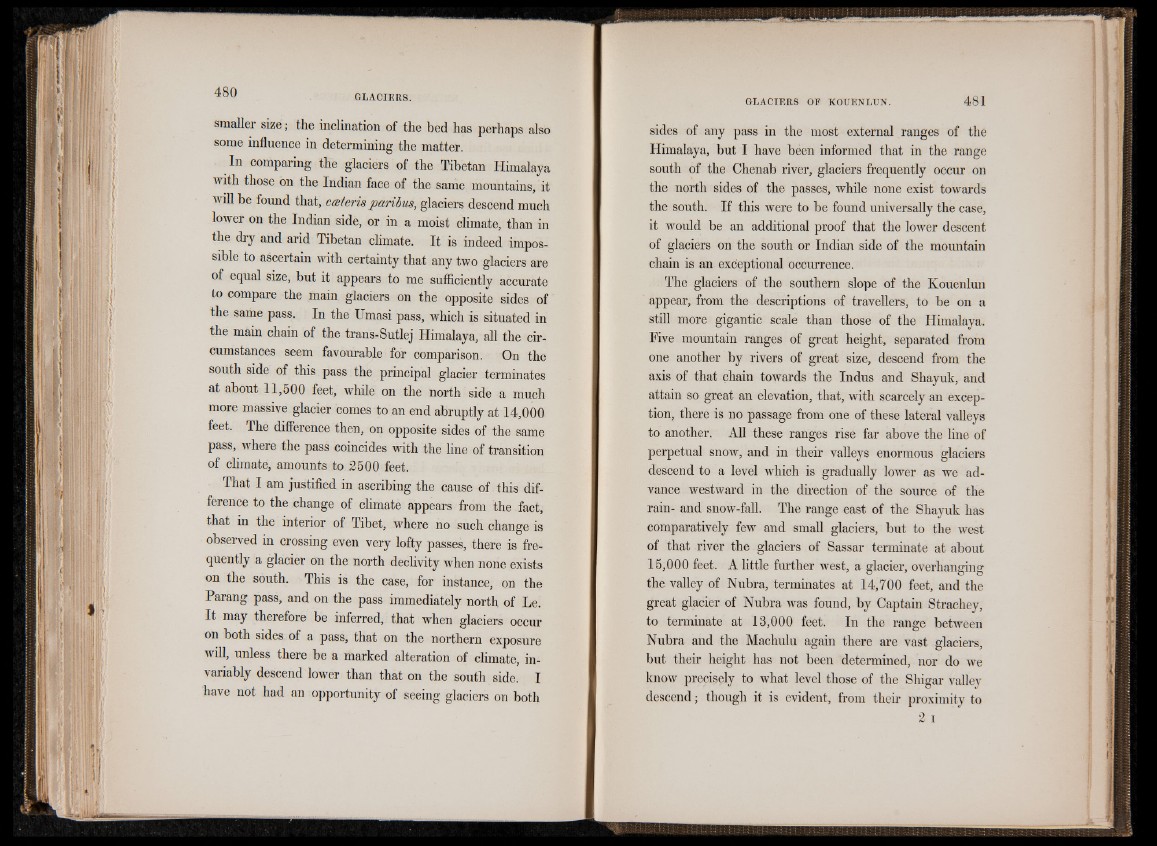
smaller size; the inclination of the bed has perhaps also
some influence in determining the matter.
In comparing the glaciers of the Tibetan Himalaya
with those on the Indian face of the same mountains, it
will be found that, cceteris paribus, glaciers descend much
lower on the Indian side, or in a moist climate, than in
the dry and arid Tibetan climate. It is indeed impossible
to ascertain with certainty that any two glaciers are
of equal size, but it appears to me sufficiently accurate
to compare the main glaciers on the opposite sides of
the same pass. In the Umasi pass, which is situated in
the main chain of the trans-Sutlej Himalaya, all the circumstances
seem favourable for comparison. On the
south side of this pass the principal glacier terminates
at about 11,500 feet, while on the north side a much
more massive glacier comes to an end abruptly at 14,000
feet. The difference then, on opposite sides of the same
pass, where the pass coincides with the line of transition
of climate, amounts to 2500 feet.
That I am justified in ascribing the cause of this difference
to the change of climate appears from the . fact,
that in the interior of Tibet, where no such change is
observed in crossing even very lofty passes, there is frequently
a glacier on the north declivity when none exists
on the south. This is the case, for instance, on the
Parang pass, and on the pass immediately north of Le
It may therefore be inferred, that when glaciers occur
on both sides of a pass, that on the northern exposure
will, unless there be a marked alteration of climate, invariably
descend lower than that on the south side. I
have not had an opportunity of seeing glaciers on both
sides of any pass in the most external ranges of the
Himalaya, but I have been informed that in the range
south of the Chenab river, glaciers frequently occur on
the north sides of the passes, while none exist towards
the south. If this were to be found universally the case,
it would be an additional proof that the lower descent
of glaciers on the south or Indian side of the mountain
chain is an exceptional occurrence.
The glaciers of the southern slope of the Kouenlun
appear, from the descriptions of travellers, to be on a
still more gigantic scale than those of the Himalaya.
Pive mountain ranges of great height, separated from
one another by rivers of great size, descend from the
axis of that chain towards the Indus and Shayuk, and
attain so great an elevation, that, with scarcely an exception,
there is no passage from one of these lateral valleys
to another. All these ranges rise far above the line of
perpetual snow, and in their valleys enormous glaciers
descend to a level which is gradually lower as we advance
westward in the direction of the source of the
rain- and snow-fall. The range east of the Shayuk has
comparatively few and small glaciers, but to the west
of that river the glaciers of Sassar terminate at about
15,000 feet. A little further west, a glacier, overhanging
the valley of Nubra, terminates at 14,700 feet, and the
great glacier of Nubra was found, by Captain Strachey,
to terminate at 13,000 feet. In the range between
Nubra and the Machulu again there are vast glaciers,
but their height has not been determined, nor do we
know precisely to what level those of the Shigar valley
descend; though it is evident, from their proximity to